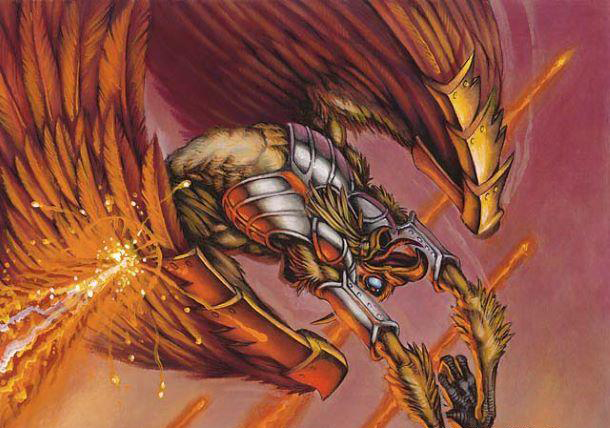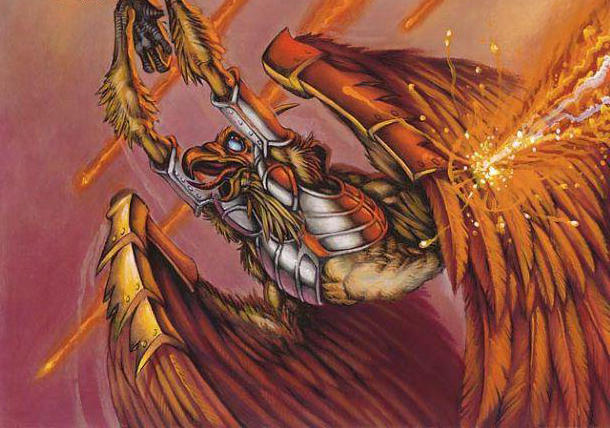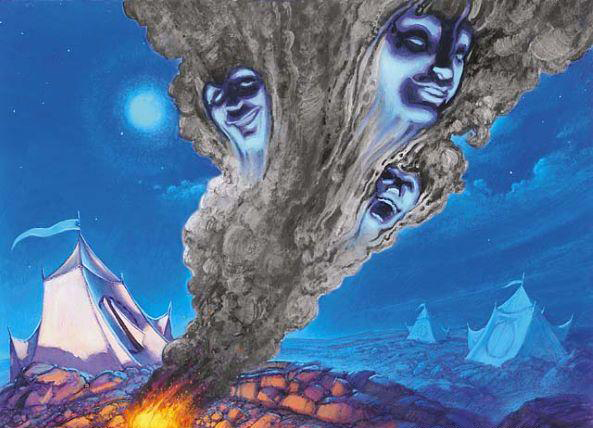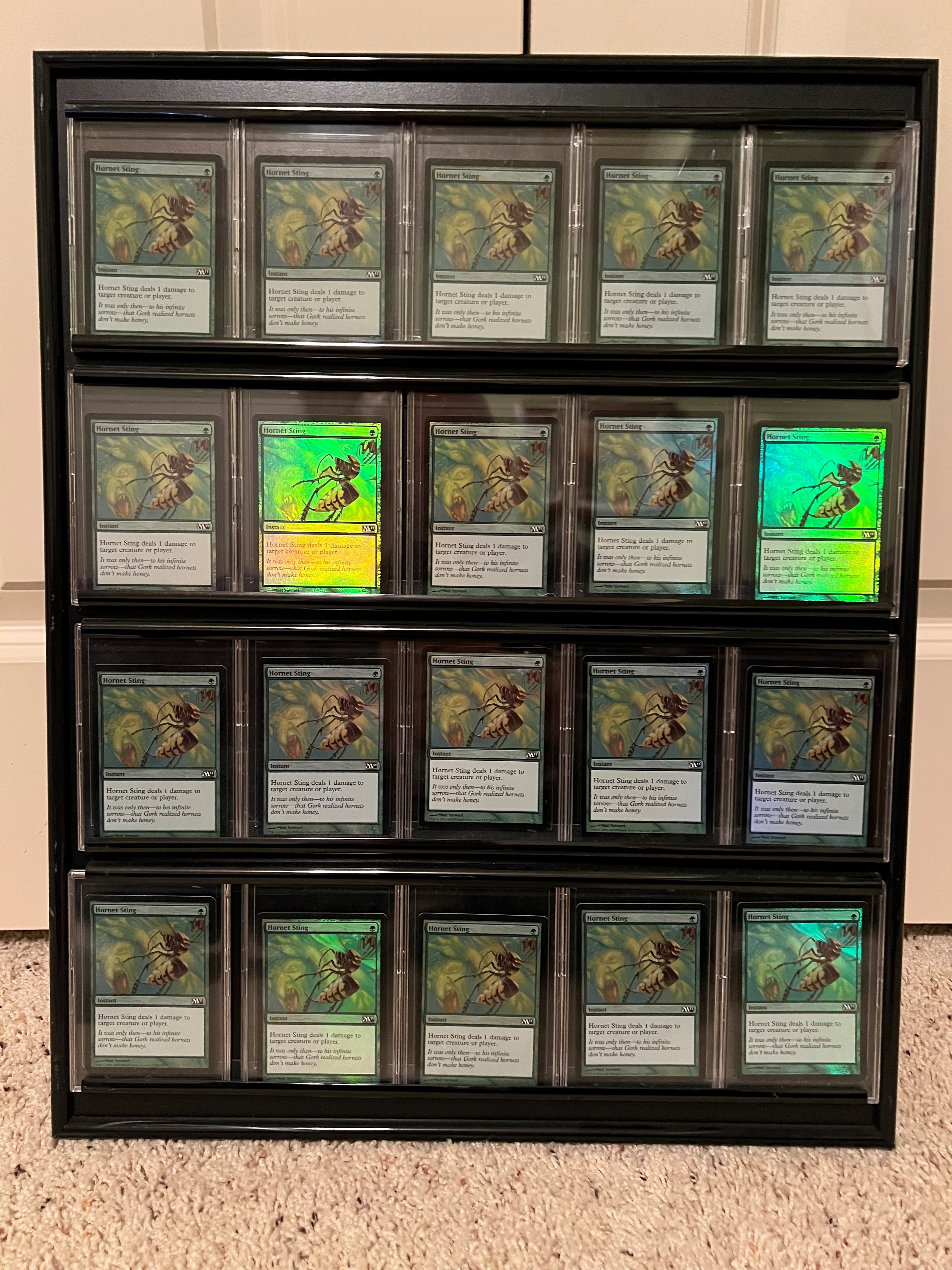Magic Design from A to Z, Part 1
For today's column, as well as the next two, I thought it would be fun to tell a bunch of short stories about Magic design. I've picked 26 cards and sorted them A through Z. For each card, I'll tell a fun story about its design. I tried to pick stories I haven't told, but there are a few favorites that I couldn't find written down in any articles that I might have told elsewhere (and it's just hard not to repeat anything with the amount of material I produce). I hope you enjoy them.
Abduction
When Michael Ryan and I original pitched the Weatherlight Saga to the Magic brand team, the plan had been to start with Tempest, but they were so excited, they asked if we could start with Weatherlight (which obviously wasn't called Weatherlight at the time). The idea we agreed to was to tell the setup of the story. We'd see Sisay get kidnapped and watch the Weatherlight crew come together to rescue her.
The set was far along, but we hadn't done any of the art yet, so Michael and I worked with the creative team, which was mostly just Pete Venters, to figure out how we could tell the early part of the story through art using the cards already in the set. One of the biggest challenges was figuring out how to show Sisay getting kidnapped. It was the event that puts the entire Weatherlight Saga into motion, so we knew we had to have it.
The only card that seemed remotely plausible was a blue spell that gained control of an opponent's creature. It had a weird graveyard rider (the set had a graveyard theme) that didn't make any sense, but we couldn't find any other option, so we changed the name to
Bake into a Pie
When we were designing Throne of Eldraine, we worked with the creative team to figure out what was off limits for the fairy-tale portion of the set. For example, we decided that the set wouldn't have talking animals. Another thing we agreed on was that nursery rhymes would be off limits. So, imagine my surprise when a year or so later, I see the art and name for
Me: Is this card name real?
Them: Yes.
Me: Can it be changed?
Them: I doubt we'll change it. The art is top-down from the name.
Me: I thought we weren't using nursery rhymes.
Them: We're not.
Me: So, Bake into a Pie?
Them: What about it?
Me: Where does the name come from?
Them: Some fairy tale.
Me: No, it's the "Song of Sixpence," a nursery rhyme.
Them: I don't know it.
Me: "Sing a song of sixpence, pocket full of rye; four and twenty blackbirds, baked into a pie."
Them: I do know that.
Me: It's from a nursery rhyme.
Them: Oh.
We end up doing a bunch of research and discovered that there are a number of Grimms' fairy tales where people get killed and baked into food, although I'm not sure if ever specifically called a pie, but we decided that we could squint and say it matched themes from the source material we were allowed to use, and Baked into a Pie was allowed to stay.
Cease-Fire
One day, many years ago, Bill Rose pulled me into his office. He said he had a favor to ask of me. The last member of the creative team had just put in their notice, which meant there was no one to work on the upcoming set Odyssey. (This obviously was many years ago.) I'd led all the creative work on Unglued and did a bunch of creative work for Urza's Legacy, so I was the R&D member with the most experience in it. Would I lead the creative for Odyssey? I'd led the design for it and was happy to help out, so I said sure.
Anyway, cut to numerous months later, and I found myself in a room looking at all the art from the set. At the time (it's not something we do now), we'd do a pass where we would look at the art to see if we wanted to do any swaps. For some reason, with Odyssey, we made a whole bunch of swaps. For example, this art (from

Was actually turned in as this art:

This was for the card
The flame was hitting the Aven to demonstrate that it was immune to it (as it had protection from red), but too many people were reading it as if the Aven was harmed, so we decided to move it to a red direct-damage spell. I assume we turned it upside down (after talking with the artist) as it put more focus on the damage than the creature.
A lot of art swaps happened until we ended up with one spell and one piece of art. Here was the art:

And here was the card: "Target player can't cast creature spells this turn. Draw a card."
Bill looked at me and said, "Can the creative make this work?" to which I said, "Sure, I guess."
I spent several days thinking about this puzzle until one day it hit me. I could name the card
Dead Ringers
I'll start by admitting that I designed this card. Well, I designed the card that turned into this card. It's a cautionary tale of how good intentions can get you to a bad place.
Let me start by showing you what this card began as:
Destroy two target creatures that share a color.
Pretty simple. If card A is red and card B is also red, you can destroy both. This is what I designed. In development, a few things came up.
First, at the time, we didn't let black kill black creatures. This was a weird carryover from
When the card came out, everyone asked me if I'd designed it, and I said yes, but no one seemed to listen when I explained all the above, so people just mocked me on social media (I'm used to it, but still). That is how a cute little card ended up getting me mocked relentlessly.
Elephant Ambush
It's Odyssey design, and we were making flashback cards. Green has flash, so I thought it would be cool to have a token-making instant in green. I want it to be a 3/3, as that seemed like a good size and meant it had to be an Elephant (we try to have our tokens overlap where possible; this was even more important back in the day before we regularly put token cards in booster packs). This spawned the following conversation with a fellow designer:
Them: So, what's this card?
Me: It's a flashback 3/3 token maker on an instant.
Them: Mechanically, I get it. What is it creatively?
Me: It's an elephant.
Them: Why does it have flash?
Me: Because it's jumping out at you.
Them: From where? It's an elephant.
Me: I don't know. Maybe it's hiding behind a tree.
Them: An elephant is hiding behind a tree?
Me: A sneaky one.
Them: Whatever.
That day, I changed the name to
Flicker
There was a point in time when there were only five people working fulltime in Magic R&D. We were making enough products that sometimes one person would be tasked with designing an entire product. One of those products was Urza's Destiny. You see, the design team of Urza's Destiny was me. Here's how that happened.
The set was going to have a traditional development team with a full allotment of developers (the five of us working fulltime—we were on all the development teams), so the thought was that if I did the design by myself, if anything went wrong, the development team could fix it. I remember the head designer at the time, a man named Joel Mick, asked if I felt I could design it by myself. I told him I thought I could.
One of the ideas I had was to give each color a vertical cycle, that is a common, uncommon, and rare that are all connected mechanically. (This mostly got scrapped for the finished product.)
For white, I decided to use a mechanic I'd come up with inspired by some cards I'd made in Mirage when we were messing with phasing. You see, I'd been a big advocate of cards that could phase themselves out. The one thing that bugged me, though, was that "enters the battlefield" effects didn't trigger when you phased back in. It felt like we were missing out on something fun, so I came up with the idea of an effect that exiled a permanent and then immediately brought it back. This would specifically trigger "enters the battlefield" effects, as well as create a number of other cool interactions. I called the ability flickering. So, I made an instant that flickered at common, a creature that flickered as an "enters the battlefield" effect at uncommon, and a creature with an activated ability that flickered at rare. I was proud of the vertical cycle.
In development, the rest of the development team wasn't as excited by it as I was and didn't feel it was worthy of three cards, so they removed it from the set. I really liked the effect, so I fought for it. Okay, what if it wasn't a vertical cycle? What if it was just two cards? How about one card? One card at common? One card at uncommon? One card at rare? What if it was a sorcery instead of an instant? It took a lot of work, but I managed to keep the effect in the set, albeit at rare on a sorcery. I also managed to get it named
Garbage Elemental
Both Unglued and Unhinged existed at a time when R&D wasn't very familiar with how supplemental products worked, so they were treated like small expansions. When they didn't sell as well as small expansions, they were deemed a failure, and the Un- sets were permanently shelved.
A decade later, the Council of Marks (Mark Purvis, Mark Globus, and myself) decided we were going to get another Un- set made, but the path to get there wasn't very clear. One of the ideas Mark Globus had was to lean into the experimental nature of the set. There was something R&D was interested in experimenting with, maybe the third Un- set could be that project. That thing was digital printing. Printing technology had significantly advanced, and R&D was interested in what kinds of designs it might allow us to make. Part of getting a green light was a promise that we'd test some of that new space.
The Unstable design team spent a lot of time looking into what might be possible with digital printing. One of the exciting ideas was the ability to use printing to make each card unique.
We had a lot of designs, but one of the coolest is what we called the
Even though Unstable design and development took seven years, by the time we were ready to print it, the direct-to-print technology had not advanced enough to be viable, so mid-development, we had to pull the direct-to-print cards from the file. These slots turned into the variable cards that came in different versions. To capture the feel of the original
Hornet Sting
The color pie is now overseen by the Council of Colors, but for many years, that task fell to me. It wasn't that I was officially tasked with being the caretaker of the color pie. I was just the person in R&D that cared the most, so I took on the burden of making sure we weren't creating cards we weren't supposed to. In my first year at Wizards, I was on the Mirage development team. The set had the following card:
Here's my conversation with the development team. "Them" represents the rest of the team:
Me: We can't print this. It's a color-pie break.
Them: How?
Me: Well, one of green's weaknesses is that it relies on its creatures to deal with other creatures. If green has an empty board, it shouldn't be able to kill creatures on the battlefield.
Them: Sure, but it's a bee sting. Bees are green and they sting.
Me: Well, Bees shouldn't be in green as green is bad at flying and can't do direct damage to creatures. Bees could be white.
Them: We like the flavor.
Me: We shouldn't use flavor to justify color-pie breaks. Flavor is super flexible. You can flavor anything.
Them: Eh, we like it.
So,
Anyway, Magic 2011 comes out, and I bemoan its existence online because color-pie breaks hurt my soul. A couple years later, I get a package in the mail. It turns out some fans had collected twenty foil

Isamaru, Hound of Konda
Some designs start as a cool idea that just comes to you. Some designs are generated because you're trying to solve a problem. Some designs are born to capture the top-down flavor of a card. A few designs come about because you're trying to prove something. Isamaru is one such card. The story begins in a Champions of Kamigawa development meeting. After much discussion, we decided the major theme of the set is legendary permanents, especially legendary creatures. This resulted in all the rare creatures, and some uncommons, being legendary. (For fans of Magic history, this is the decision that would lead me to coin my "if your theme's not at common, it's not your theme" truism.)
On this particular day, we were talking about designing legendary creatures. One of the other developers said off the cuff, "Well they can't be vanilla" (i.e., have no rules text). I asked, "Why not?" They said that legendary creatures are supposed to feel special, and there's no way to make a vanilla creature feel special. I didn't think that was true. For example, how about W for a 2/2? We'd never done that before, and I thought people would find that cool. It got added to the file then and there.
Interestingly, this leads to a story about another card. Once we made Isamaru, the question became about whether we could do the same at mythic rare. It wasn't until years later, but I finally figured out how to make one. Can you name it?
-
Click here to see it
-
Infinity Elemental
You Can Alphabet I'll Continue This
That's all the time I have for now. I hope you've enjoyed the stories. As always, I'm eager to hear your feedback. Do you enjoy these types of articles? Are there different types of stories you'd like to hear? You can email me or contact me through my social media accounts (Twitter, Tumblr, Instagram, and TikTok) with feedback.
Join me next week when I pick up where we left off.
Until then, may you make your own stories with all these cards.
- Episode 946 Gatecrash
- Episode 945 Return to Ravnica
- Episode 944 Deciduous

